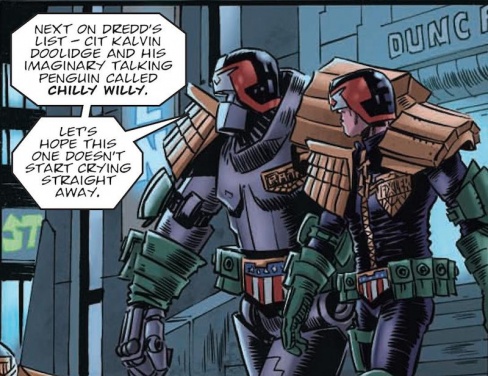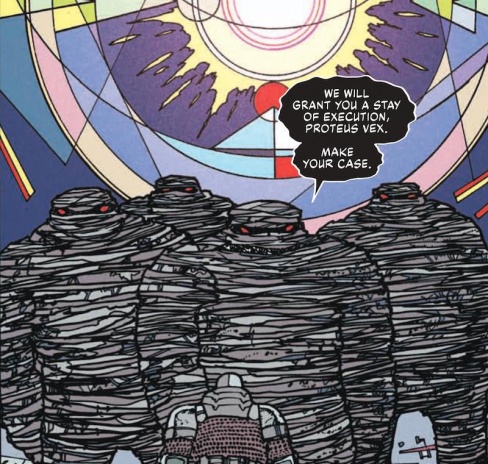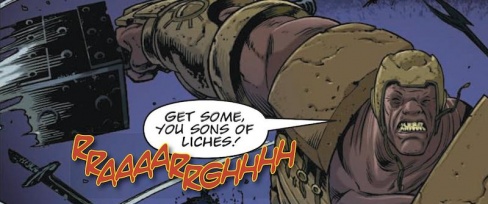
Welcome, Earthlets, to Multiver-City One, our “2000 AD” weekly review column! Every Wednesday we examine the latest offerings from Tharg and the droids over at Rebellion/2000 AD, the galaxy’s leading producers of Thrill-Power entertainment. Let’s get right to it!

THIS WEEK IN 2000AD

Judge Dredd: Kill Bloopy Part 2
Credits Kenneth Niemand (script) Dan Cornwell(art) Jim Boswell(colours)Annie Parkhouse(letters)
Michael Mazzacane: Kenneth Niemand makes good use of the bureaucratic staleness that being a Judge would entail. There is a overly diagnosed verbiage to Judge Patsy and their partners investigation of Dr. Ditka’s therapy group. There’s no real care involved as Patsy dismantles and dismisses this citizen. It allows the final joke on the page to land as it draws comparisons between how Judges treat and act around citizens and each other. Annie Parkhouse’s choice of letter boxes, the more angular boxy kind for Patsy and normal round ones for their partner helps to gives them both distinct voices quickly. The opening page manages to cram a lot of plot movement into three scenes spread over four panels without feeling rushed.
The deceptively simple qualities to Jim Boswell’s palette come through in this strip as they bath just about everything in the cold blue light of a TV. It creates the opposite feeling compared to the last strip, now everything seems cold and even more irksome.as Bloopy tells him he too has an imaginary friend. There isn’t anything showy or spectacular about these pages, it reinforces the monotony of the babysitting assignment and unflappability of Dredd. And then everything becomes bathed in the warm glow of exploding H-Wagon fuel as the Imaginary Friend Killer strikes! Keeping everything else so chromatically cold really makes the explosions and gunfire stand out and increase the shock value of the sudden excitement.
The fall of the H-Wagon is a nicely done three panels. Through a mixture of panel shapes, Cornwell is able to establish a sense of failing verticality before it inevitably comes into a rough landing.
Structurally, Niemand is able to make the second part of ‘Kill Bloopy’ work as an episode. He sets something up on the first page and pays it off by the end which helps to propel readers into the third. Like Cornwell’s page design there is a plain readability to this strip that hides the little flourishes that make this strip function so well.

Brink: Hate Box, Part Fifteen
Credits: Dan Abnett (script), Inj Culbard (art), Simon Bowland (letters)
Rowan Grover: “Hate Box” is still powering along presenting its protagonist Bridget in a determined yet cool-headed manner. At this stage, however, every time the story feels like it could be wrapped up neatly, another plot twist is added to derail everything again. Bridget is characterized with a lot of fun mannerisms here, such as her use of the maniacal red thread to connect all the dots on her theories. Having Tunde Weyowa back as her ‘clean cop’ assistant is great in this situation, as even with his easily terrified and meek personality, he sees this situation as volatile enough to try and convince Bridget out of it. The final scene bringing the morally grey but likable Adrienne Picazo at odds with Bridget is great too, but it does feel somewhat like retreading old plot threads from the beginning of the series.
Culbard does solid work as usual, especially in the start rendering Bridget with a cranky yet level-headed attitude. Her constant frown is emblematic of her personality by this stage of the story, and Culbard leans into it appropriately. The red thread board is also appropriately dizzying, with just enough detail being added to each paper to make it feel overly complicated but simple enough that it doesn’t distract from the focal point. There’s some great extreme emotional acting in the final scene with Adrienne, too. Culbard gives her a maniacal ruthlessness in how excited she is about catching a felon, showing that extra creepy pleasure she takes in her job. When Bridget steps in to intervene, Adriene is well depicted with the complete opposite of the emotional spectrum, looking like a child poised to through a tantrum.
Continued below“Hate Box” feels longer than it needs to be, and yet Abnett and Culbard still give legitimate reasons to enjoy this series. The characters are interesting and well-developed, and the art has grown to a point where the acting is well-conveyed and illustrated.

Proteus Vex: Another Dawn Part 3
Michael Carroll (script), Henry Flint(art), Simon Bowland (letters)
Greg Lincoln: Vex gets a stay of execution after a terribly uncomfortable silence as his fate is decided by the Scorchers. His revelations about the potential threat posed to them by his current bounty was apparently very convincing. Rho 7 Baryon is apparently in addition to being a fugitive is also a murderer and as Vex. The plot thickens for Vex as he learns there is a potential method of removing the permanent tracking implant. The higher points of interest in the story though meter as Vex pick up the very interesting incidental flesh pilot from part one and the obvious attack on Vex’s ship that his compelling prisoner most likely dispatched. Carroll’s story feels like it’s got a lot going on but up till now little of it has involved Proteus Vex. Here’s hoping this is the set of hooks to get the story really going.
Henry Flint does a lovely job in bringing interest to the hooks in the script. As there is yet more exposition Flint treats us to the events taking place with Midnight Indicating Shame on Vex’s supposedly safe ship. He’s put images with a lot of visual interest throughout but when he reintroduces color the story comes alive again. The vibrancy of the scenes with Midnight and the sequence where Vex makes good on his debt to the being protecting the Flesh Pilot brings the world back to life. Henry Flint can make faces that lack fully human features communicate so much and he makes it seem effortless on these pages.

The Zaucer of Zilk: Part 3 – A Zaucerful of Secrets
Peter Hogan (Script), Brendan McCarthy (Art, Colors, & Story), Len O’Grady (Colors), Jim Campbell (Letters)
Christopher Egan: As part 3 of ‘A Zaucerful of Secrets’ opens, the The Tailor of Tales seems unwilling, or at least unready to spill the details on what will happen next. Unfortunately for him, he is about to become a part of the story he is recounting. It is here that, if only for a moment, narrator and narration exist together. It is at this moment that a stampede of bionic pants led by T’Tooth comes storming through The Tailor’s store destroying everything in its path before moving on.
The Tailor is clearly getting tired of this story and readers may be feeling the same way. After the action and information packed introductory issue, the story is quickly losing steam as it moves along to chapter 3. It’s giving us all the same energy and rainbow aesthetic, but heart of it all is wavering. After the silly pants parade, the story moves back to the Zaucer’s search for his wand. Already becoming frustrated as all leads seem to be just out of reach, he finally catches up to Craggaknock who is holding the wand at the Carnival of Light.
Calling out ol’ Craggy in front of the crowds, the villainous bruiser won’t be giving up the wand or his hold over the Zaucer without a fight. The issue leaves off with a worthy cliffhanger, but if things don’t become consistently more exciting, it is going to take a lot more than silly jargon and an acid trip environment to keep things interesting. McCarthy and Hogan might be having fun with this story, but it’s starting to get a little stale.
‘A Zaucerful of Secrets’ part 3 has its moments, but overall is predictable and missing some of the zeal that the more adventurous previous entries had in spades.

Feral & Foe: Part Three
Credits: Dan Abnett (script), Richard Ellson (art), Richard & Joe Ellson (colors), Annie Parkhouse (letters)
Christa Harader: Well, they’ve gotten themselves a tank. His name’s Ugbrant, he’s a giant amicable gladiator who won’t stop talking, and he blazes a path of destruction the likes of which the previous five individuals couldn’t quite manage.
Abnett and Ellson are doing a good job keeping the tone light in these middle installments. The first part had a lot of quick world-building to do, and while it did it well it’s nice to settle deeper into the story and have a character set piece to break things up. We’ll no doubt get back to some of the melodrama as “Feral and Foe” wraps, but the interlude here is timed and crafted well. The Ellsons choose some brighter colors – as compared to the previous dim interiors – for backgrounds that help set off Ellson’s detailed art and highlight the clean line. Ugbrant’s face is a study, at once serene as he speaks and brutal to match his clobbering power. Character design continues to entertain, and the gore textures are appropriate. Parkhouse has three talkative characters to handle in this installment, and the lettering remains up to the high standard established in the first part.
Ugbrant’s a worthy and entertaining addition to the cast – though who knows how long he’ll last, given Wrath and Bode’s track record – and “Feral and Foe” continues to entertain with crisp dialogue, good plotting and imaginative art.






